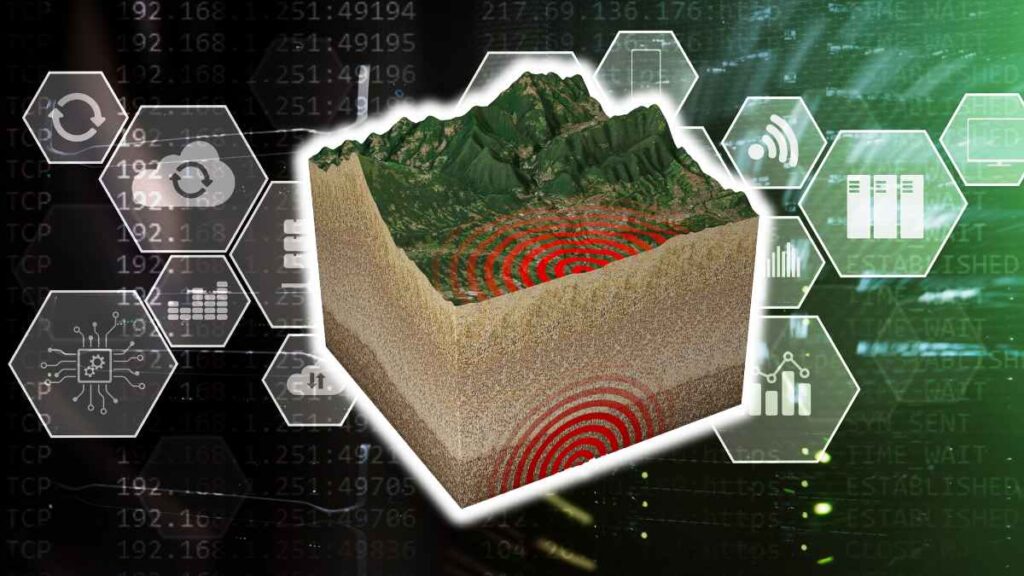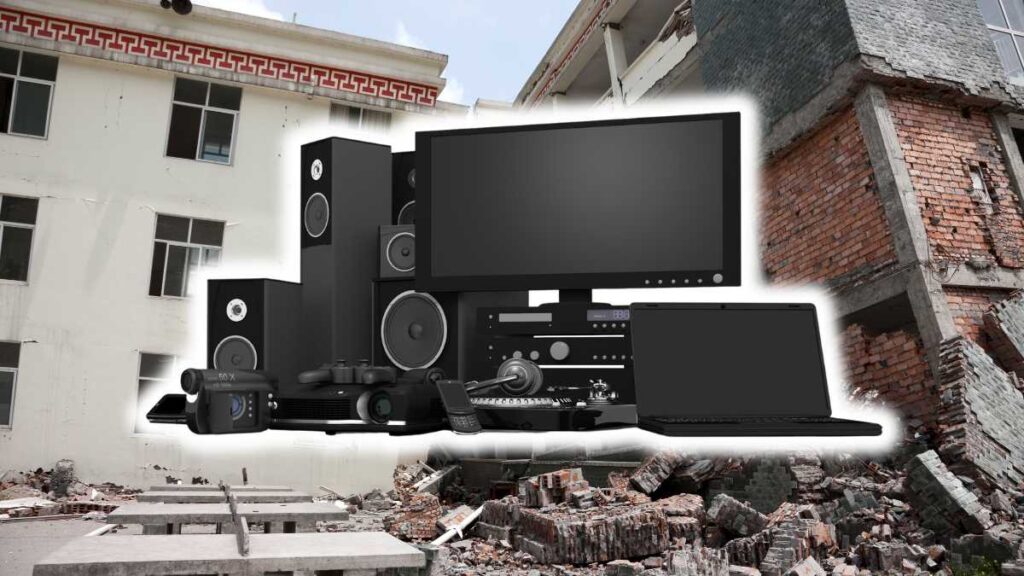Teaching your kids about safety during earthquakes is crucial, and you can go beyond the basic lessons. Here are 50 tips on what lessons you can teach your kids if there’s an earthquake in addition to the Drop, Cover, and Hold On method.
Contents
Toggle1. Know the Safe Spots
Teach your children about safe spots in each room. It’s a fun activity you can do together, identifying parts of your home where they can take cover. These spots are usually under sturdy furniture or against an interior wall, away from windows, glass, or heavy objects that could fall.
2. Know the Dangerous Zones
In addition to knowing the safe places, it’s also essential to recognize the dangerous zones in your home. These are places near windows, mirrors, hanging objects, fireplaces, and tall furniture.
3. Practice Makes Perfect
Regularly practicing what to do during an earthquake can be a great lesson. Conducting earthquake drills will help the information to stick and reduce panic when an earthquake occurs.
4. Learn to Use a Fire Extinguisher
Post-earthquake fires can be a risk due to gas leaks or electrical shorts. Teaching older children how to use a fire extinguisher could be lifesaving. Remember, this should be age-appropriate and only for older kids, and always stress that their safety comes first – if a fire is too big, it’s time to get out and let professionals handle it.
5. Communication Plan
Create a communication plan for your family when you are not together during an earthquake. Ensure each family member knows how to get in touch with each other and establish a safe meeting place.
6. Emotional Preparedness
Earthquakes can be scary, and it’s normal to be scared. Encourage your kids to express their feelings and reassure them that feeling this way is okay. Teach them some basic breathing exercises to stay calm.
7. Earthquake-Specific First Aid
While this is more suitable for older children, learning basic first aid techniques like treating cuts, fractures, or bruises can be an added advantage during post-earthquake scenarios. Always ensure they know to call for professional medical help when needed.
8. Be Aware of Your Surroundings
Teach your children always to be aware of their surroundings. The lesson includes being mindful of potential hazards that could become dangerous during an earthquake, such as tall, heavy bookshelves or light fixtures that could fall.
9. Know Your Local Earthquake Safety Regulations
Many schools and public buildings have specific protocols for earthquakes. Ensure your children understand these and can follow them when they’re not at home.
10. Learn to Switch Off Utilities
Teach older kids how to turn off utilities like water, gas, and electricity if there is a leak or electrical issue after an earthquake. This lesson is an advanced skill, so ensuring your children are old enough to handle this safely is essential.
RELATED: 7 steps how to plan and execute earthquake drills for your family
11. Importance of Shoes
Teach your children to keep a pair of sturdy shoes under their bed. After an earthquake, there might be broken glass or debris on the floor, so having shoes on will protect their feet if they need to move to a safer location.
12. Use of Technology
Teach your children how to use mobile apps and other technology that can help during an earthquake. This lesson could include apps that provide updates on the situation, allow for communication with family members, or even give instructions on first aid. Make sure they understand the importance of saving battery life during such situations.
13. Understand the Alerts and Signals
Kids should know what different sirens or alerts in your area mean. If your region has an earthquake warning system, explain how it works and what they should do when they hear it.
14. Memorize Important Information
Ensure your children memorize important phone numbers and addresses if separated from you during an earthquake. This information can help them reach out for help or provide valuable information to rescuers.
15. Emergency Contacts
Along with memorizing important phone numbers, having a list of emergency contacts in a clear, easy-to-find place would be beneficial. Teach your child where this list is and how to use it.
16. Basic Survival Skills
Teach your child some basic survival skills. This lesson can include how to find and purify water, signal for help, and stay warm without power. While these skills are generally more suitable for older kids, younger children can still learn the basics.
17. Pet Safety
If you have pets at home, involve your children in preparing a pet emergency kit. Explain the importance of keeping pets safe and calm during an earthquake.
18. Understanding Earthquake News and Updates
Older children should understand how to access and interpret earthquake news updates from a trusted website, radio, or TV station. They should be taught to understand commonly used terminology, like ‘magnitude,’ ‘epicenter,’ and ‘aftershocks.’
19. Buddy System
If your children are old enough to be at school or do other activities without you, talk to them about the importance of staying with a buddy during and after an earthquake. It’s always safer to have two heads than one when dealing with a situation.
20. Safe Evacuation
Teach your child how to evacuate buildings and houses safely. Emphasize the importance of not using elevators during an earthquake and instead using stairways.
RELATED: Should you inspect your house after an earthquake? Ultimate guide
21. Recognize Landslide Prone Areas
If you live in a hilly area, teach your children to recognize signs of potential landslides, which earthquakes can trigger. These can include new cracks or bulges in the ground, soil moving away from foundations, and leaning trees or poles.
22. Earthquake Myths and Facts
Teach your kids to differentiate between myths and facts about earthquakes. For instance, debunk the myth that a doorway is the safest place to be during an earthquake (this is only true for older, unreinforced adobe houses) or that animals can predict earthquakes.
23. Importance of Hygiene
After an earthquake, it’s crucial to maintain hygiene to prevent the spread of diseases. Teach them about the importance of cleaning their hands before eating, proper disposal of waste, and not touching their face with dirty hands.
24. Reading an Earthquake Map
Older kids might benefit from learning how to read an earthquake map. This lesson can give them a better understanding of the quake’s epicenter and its potential effects on nearby regions.
25. Recognizing Structural Safety
Teach kids about the importance of structural safety. Help them understand the difference between a building more likely to withstand an earthquake (reinforced concrete, wooden structures) and those that aren’t (unreinforced masonry).
26. Learn to Spot Structural Damage
Older kids can learn to identify signs of structural damage in your home that may make them unsafe after an earthquake, like large cracks in the walls, ceilings, or foundations.
27. Dealing with Power Outages
Teach kids what to do during power outages, like how to safely navigate the home without lights, only to open the fridge or freezer if necessary to maintain the cold, and that devices should only be used sparingly to preserve battery life.
28. Mental Preparedness
Teach your kids about the importance of mental preparedness. Encourage them to think positively, use problem-solving skills, and stay calm. Teach them mindfulness exercises or visualization techniques to cope with stress.
29. Importance of Following Directions
Stress the importance of following directions from trusted adults and authorities, such as parents, teachers, emergency responders, and news broadcasts.
30. What to Do if You’re Near the Ocean
If you live near the ocean, you must teach your children about the risk of tsunamis, which earthquakes can trigger. If they feel an earthquake near the beach, they should know to move to higher ground as soon as the shaking stops.
31. Outdoor Safety
Ensure your children know what to do if they’re outside when an earthquake occurs. Teach them to move away from buildings, trees, streetlights, and utility wires, as these can be dangerous if they fall during an earthquake.
RELATED: How to Stay Safe During an Earthquake while Walking in the Street – 6 plus More Tips
32. Learn to Recognize Possible Hazards
Teach your children to identify potential earthquake hazards, such as unsecured furniture or appliances that could fall over or areas of your home where glass could shatter.
33. Food and Water Safety
Teach your children about food and water safety after an earthquake. Explain that food and water supplies may become contaminated, and they should only consume items that have been properly stored and are confirmed safe.
34. Use of Safety Equipment
Ensure your children know how to use essential safety equipment like helmets, knee pads, and sturdy shoes, which can help protect them from debris during and after an earthquake.
35. Create a Distress Signal
Teach your kids how to signal for help if trapped after an earthquake. This lesson can be as simple as blowing a whistle, shouting at regular intervals, or using a flashlight or phone light.
36. Respect for Nature’s Power
Use this as an opportunity to teach kids about respecting the power of nature. Explain that while we can’t control events like earthquakes, we can control our preparedness and response.
37. Building a Community Network
Teach your children about the importance of community support during emergencies. Encourage them to know their neighbors and build a network of trusted individuals who can assist them if you are not around.
38. Noise Awareness
Kids should understand that an earthquake has distinct sounds. The rumbling noise accompanying an earthquake can be scary if not expected. By telling your kids about this beforehand, they can be more prepared and less frightened.
39. Document Safety
Teach children the importance of vital documents like birth certificates, insurance papers, etc. While it’s not their responsibility to safeguard these, creating awareness about their importance is useful.
40. Traffic Rules During an Earthquake
For older kids who may be riding bikes, it’s essential to teach them about road safety during an earthquake. They should get off the road and stay in an open space until the shaking stops.
41. Identifying Safe Shelter
Teach your child to identify safe shelter places like designated evacuation centers or community centers that provide shelter during natural disasters.
42. Non-Verbal Communication
Non-verbal communication can be an essential skill during a crisis. Teach kids to communicate using simple signals, especially when phone lines are down or speech isn’t possible.
43. Online Safety Post-Earthquake
Older children should be taught about staying safe online after an earthquake, particularly on social media platforms. They should be careful not to share false information and only rely on trusted sources for updates.
44. Use of Emergency Tools
Educate your children about simple emergency tools and their use. This lesson can include items like flashlights, hand-crank radios, whistles, or dust masks. Be sure they understand these are to be used only during emergencies, not as toys.
45. Emergency Signal Understanding
Your children should understand different emergency signals, such as sirens or emergency broadcast system alerts. Talk to them about how to respond to these signals.
46. Long-Term Preparedness
Teach children the concept of long-term preparedness. An earthquake may lead to a situation where they must be self-sufficient for days. They should understand that food, water, and other necessities should be used wisely in such cases.
47. Keeping Personal Items Safe
Teach your children about securing personal items. This lesson includes securing school backpacks and other belongings so they don’t scatter during an earthquake.
48. Importance of Sleepwear
Make sure your children understand the importance of wearing proper sleepwear. Sturdy sleepwear can protect against minor scrapes and scratches from debris during an earthquake at night.
49. Using Bicycles Safely
If your child rides a bicycle, make sure they know what to do if an earthquake happens while they’re cycling. They should get off the road, park their bicycle safely, and protect themselves until the shaking stops.
50. Understanding Aftershocks
Children must understand that earthquakes often have aftershocks. They should know that when the shaking stops, it doesn’t mean the earthquake is over.
RELATED: How long after an earthquake can aftershocks happen, and what is the interval?
Conclusion
In imparting these lessons, always adapt the content to the age and maturity of your child. The aim is not to create fear but to equip them with the knowledge and skills to remain safe during an earthquake. Strive to keep learning enjoyable, turning these teachings into games or interesting discussions rather than imposing them as serious lessons.
Regularly revisit these lessons and conduct drills, fostering a family culture of preparedness. This consistent engagement helps ensure that safety measures become second nature to your children. They need to feel comfortable discussing these topics with you, enhancing their confidence and preparedness.
Incorporate these teachings into regular family conversations and activities. This manner can help your child stay engaged, and they’re more likely to retain the information when presented in a relaxed and engaging way. Remember, the ultimate goal is to empower your children with the tools and knowledge they need to navigate the unpredictable event of an earthquake while still making them feel safe and secure.
Lastly, remember that while the lessons are essential, the reassurance from a caring adult remains invaluable during stressful situations. Your support and calm demeanor can help them manage their fears effectively and respond confidently in the event of an earthquake.
RELATED:
Bibliography
- Earthquake Safety Tips | Save the Children. https://www.savethechildren.org/us/charity-stories/earthquake-tips
- Preparing for an Earthquake | Natural Disasters and Severe Weather | CDC. https://www.cdc.gov/disasters/earthquakes/prepared.html
- Earthquake Preparedness What Every Child Care Provider Needs to Know. https://www.ready.gov/sites/default/files/2020-03/earthquakes_what-child-care-providers-need-to-know.pdf
- Earthquake Safety | Earthquake Preparedness | Red Cross. https://www.redcross.org/get-help/how-to-prepare-for-emergencies/types-of-emergencies/earthquake.html
- Earthquake safety tips, preparation, and readiness – National Geographic. https://www.nationalgeographic.com/environment/article/earthquake-safety-tips




